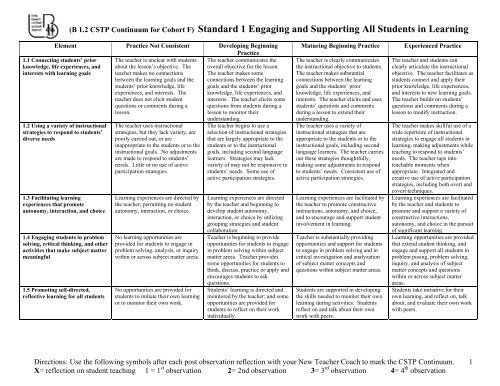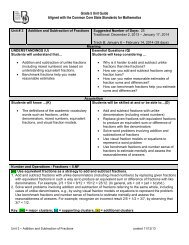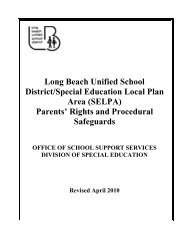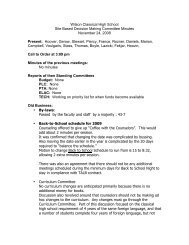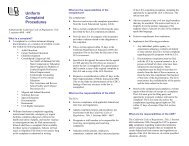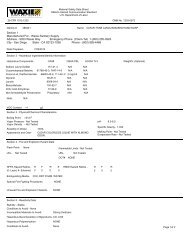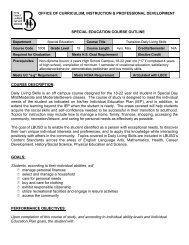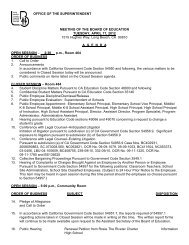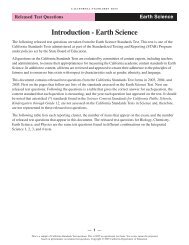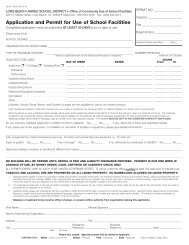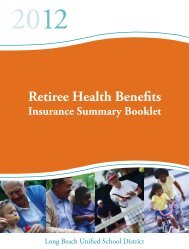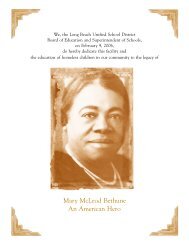Standard 1 Engaging and Supporting All Students in Learning
Standard 1 Engaging and Supporting All Students in Learning
Standard 1 Engaging and Supporting All Students in Learning
- No tags were found...
Create successful ePaper yourself
Turn your PDF publications into a flip-book with our unique Google optimized e-Paper software.
<strong>St<strong>and</strong>ard</strong> 2 Creat<strong>in</strong>g <strong>and</strong> Ma<strong>in</strong>ta<strong>in</strong><strong>in</strong>g Effective Learn<strong>in</strong>g EnvironmentsElement Practice Not Consistent Develop<strong>in</strong>g Beg<strong>in</strong>n<strong>in</strong>g Practice Matur<strong>in</strong>g Beg<strong>in</strong>n<strong>in</strong>g Practice Experienced Practice2.1 Creat<strong>in</strong>g a physicalenvironment that engages allstudentsThe physical environment does notesupport student learn<strong>in</strong>g. There areone or more safety hazards, <strong>and</strong>materials are difficult to access whenneeded.The physical environment isarranged for safety <strong>and</strong> accessibility,<strong>and</strong> it facilitates <strong>in</strong>dividual studentengagement <strong>in</strong> learn<strong>in</strong>g.The arrangement of the physicalenvironment ensures safety <strong>and</strong>accessibility. Most students workwell <strong>in</strong>dividually or together as theyparticipate <strong>in</strong> learn<strong>in</strong>g activities.The arrangement of the physicalenvironment ensures safety <strong>and</strong>accessibility, <strong>and</strong> facilitatesconstructive <strong>in</strong>teraction <strong>and</strong>purposeful engagement for all2.2 Establish<strong>in</strong>g a climate thatpromotes fairness <strong>and</strong> respect2.3 Promot<strong>in</strong>g social development<strong>and</strong> group responsibility2.4 Establish<strong>in</strong>g <strong>and</strong> ma<strong>in</strong>ta<strong>in</strong><strong>in</strong>gst<strong>and</strong>ards for student behavior2.5 Plann<strong>in</strong>g <strong>and</strong> implement<strong>in</strong>gclassroom procedures <strong>and</strong> rout<strong>in</strong>esthat support student learn<strong>in</strong>g2.6 Us<strong>in</strong>g <strong>in</strong>structional timeeffectivelyThe classroom climate ischaracterized by unfairness ordisrespect, either between the teacher<strong>and</strong> students or among students.<strong>Students</strong> are unwill<strong>in</strong>g to take risks.Teacher response to <strong>in</strong>appropriatebehaviors is unfair or <strong>in</strong>equitable.<strong>Students</strong>’ social development, selfesteem,<strong>and</strong> diversity are notsupported, <strong>and</strong> students have nosense of responsibility for each other.No st<strong>and</strong>ards for behavior appear tohave been established, or studentsare confused about what thest<strong>and</strong>ards are. Teacher does notunderst<strong>and</strong> that st<strong>and</strong>ards must betaught.Classroom procedures <strong>and</strong> rout<strong>in</strong>eshave not been established or are notbe<strong>in</strong>g enforced. Teacher does notunderst<strong>and</strong> that procedures <strong>and</strong>rout<strong>in</strong>es must be taught.Learn<strong>in</strong>g activities are often rushedor too long, <strong>and</strong> transitions are roughor confus<strong>in</strong>g, result<strong>in</strong>g <strong>in</strong> a loss of<strong>in</strong>structional time.A climate of fairness, car<strong>in</strong>g, <strong>and</strong>respect is established by the teacherfor most students, but few studentstake risks <strong>and</strong> the teacher does littleto encourage them. For the mostpart, the pattern of teacher responseto <strong>in</strong>appropriate behavior is fair <strong>and</strong>equitable.<strong>Students</strong> respect each other’sdifferences most of the time <strong>and</strong>work together moderately well. Theteacher provides limitedopportunities for students to assumeresponsibility.<strong>St<strong>and</strong>ard</strong>s for behavior have beenestablished by the teacher, <strong>and</strong> theteacher’s response to studentbehavior is generally appropriate.Teacher has taught some st<strong>and</strong>ardsfor behavior. Re<strong>in</strong>forcement ofst<strong>and</strong>ards is <strong>in</strong>consistent, or focusedonly on punishment.Procedures <strong>and</strong> rout<strong>in</strong>es have beenestablished <strong>and</strong> work moderatelywell, with little loss of <strong>in</strong>structionaltime. Teacher has taught somerout<strong>in</strong>es or procedures.Re<strong>in</strong>forcement of rout<strong>in</strong>es <strong>and</strong>procedures may be <strong>in</strong>consistent, orfocused only on punishment.Instructional time is paced so thatmost students complete learn<strong>in</strong>gactivities. Transitions used to movestudents <strong>in</strong>to new activities aregenerally effective.A climate of fairness, car<strong>in</strong>g, <strong>and</strong>respect is ma<strong>in</strong>ta<strong>in</strong>ed by the teacher,<strong>and</strong> students are encouraged to takerisks <strong>and</strong> be creative. The pattern ofteacher response to <strong>in</strong>appropriatebehavior is fair <strong>and</strong> equitable.<strong>Students</strong> respect each other’sdifferences <strong>and</strong> work <strong>in</strong>dependently<strong>and</strong> collaboratively, tak<strong>in</strong>gresponsibility for themselves <strong>and</strong>their peers.<strong>St<strong>and</strong>ard</strong>s for behavior are clearlyestablished, have been taught, areclear to all students, <strong>and</strong> arema<strong>in</strong>ta<strong>in</strong>ed by the teacher. Theteacher’s response to studentbehavior is appropriate.Re<strong>in</strong>forcement of st<strong>and</strong>ards isconsistent us<strong>in</strong>g positive or negativere<strong>in</strong>forcers.Teacher has taught rout<strong>in</strong>es <strong>and</strong>procedures. Procedures <strong>and</strong> rout<strong>in</strong>eswork smoothly, with no loss of<strong>in</strong>structional time. Re<strong>in</strong>forcement ofrout<strong>in</strong>es <strong>and</strong> procedures is consistentus<strong>in</strong>g positive or negativere<strong>in</strong>forcers.Pac<strong>in</strong>g of the lesson is appropriate tothe activities <strong>and</strong> enables all studentsto engage successfully with thecontent. Transitions are smooth.students <strong>in</strong> learn<strong>in</strong>g activities.<strong>Students</strong> ensure that a climate ofequity, car<strong>in</strong>g, <strong>and</strong> respect isma<strong>in</strong>ta<strong>in</strong>ed <strong>in</strong> the classroom, <strong>and</strong>students take risks <strong>and</strong> arecreative. The patter of teacherresponse to <strong>in</strong>appropriate behavioris fair <strong>and</strong> equitable.<strong>Students</strong> work <strong>in</strong>dependently <strong>and</strong>collaboratively <strong>and</strong> ma<strong>in</strong>ta<strong>in</strong> aclassroom community <strong>in</strong> whichthey respect each other’sdifferences, assume leadership,<strong>and</strong> are responsible for themselves<strong>and</strong> their peers.<strong>St<strong>and</strong>ard</strong>s for behavior have beentaught <strong>and</strong> are <strong>in</strong>tegrated with thedaily rout<strong>in</strong>e. <strong>Students</strong> <strong>and</strong>teacher develop st<strong>and</strong>ards forbehavior together, <strong>and</strong> studentsare responsible for help<strong>in</strong>g eachother ma<strong>in</strong>ta<strong>in</strong> st<strong>and</strong>ards.Re<strong>in</strong>forcement of st<strong>and</strong>ards isconsistent <strong>and</strong> <strong>in</strong>tegrated with theuse of positive <strong>and</strong> negativere<strong>in</strong>forcers.Rout<strong>in</strong>es <strong>and</strong> procedures have beentaught <strong>and</strong> <strong>in</strong>ternalized by students <strong>and</strong>teacher. <strong>Students</strong> <strong>and</strong> teacher ensurethat classroom procedures <strong>and</strong> rout<strong>in</strong>esoperate seamlessly <strong>and</strong> efficiently.Re<strong>in</strong>forcement of rout<strong>in</strong>es <strong>and</strong>procedures is consistent <strong>and</strong> <strong>in</strong>tegratedwith the use of positive <strong>and</strong> negativere<strong>in</strong>forcersPac<strong>in</strong>g of the lesson is adjusted asneeded to ensure the engagementof all students <strong>in</strong> learn<strong>in</strong>gactivities. Transitions areseamless.Directions: Use the follow<strong>in</strong>g symbols after each post observation reflection with your New Teacher Coach to mark the CSTP Cont<strong>in</strong>uum.X= reflection on student teach<strong>in</strong>g 1 = 1 st observation 2= 2nd observation 3= 3 rd observation 4= 4 th observation2
<strong>St<strong>and</strong>ard</strong> 3 Underst<strong>and</strong><strong>in</strong>g <strong>and</strong> Organiz<strong>in</strong>g Subject Matter for Student Learn<strong>in</strong>gElement Practice Not Consistent Develop<strong>in</strong>g Beg<strong>in</strong>n<strong>in</strong>g Practice Matur<strong>in</strong>g Beg<strong>in</strong>n<strong>in</strong>g Practice Experienced Practice3.1 Demonstrat<strong>in</strong>g knowledgeof subject matter <strong>and</strong> studentdevelopmentThe teacher’s work<strong>in</strong>gknowledge of subject matter <strong>and</strong>student development is<strong>in</strong>consistently evident, does notadequately support students’learn<strong>in</strong>g, or may not be current.The teacher’s work<strong>in</strong>gknowledge of subject matter <strong>and</strong>basic pr<strong>in</strong>ciples of studentdevelopment reflects a s<strong>in</strong>gleperspective, supports somestudents’ learn<strong>in</strong>g, <strong>and</strong> is usuallyThe teacher’s work<strong>in</strong>gknowledge of subject matter <strong>and</strong>basic pr<strong>in</strong>ciples of studentdevelopment <strong>in</strong>corporatesdifferent perspectives, supportsall students’ learn<strong>in</strong>g, <strong>and</strong> isThe teacher’s work<strong>in</strong>gknowledge of subject matter<strong>and</strong> <strong>in</strong>dividual students’development <strong>in</strong>corporates abroad range of perspectives,strongly supports all students'3.2 Organiz<strong>in</strong>g curriculum tosupport student underst<strong>and</strong><strong>in</strong>gof subject matter3.3 Interrelat<strong>in</strong>g ideas <strong>and</strong><strong>in</strong>formation with<strong>in</strong> <strong>and</strong> acrosssubject matter areas3.4 Develop<strong>in</strong>g studentunderst<strong>and</strong><strong>in</strong>g through<strong>in</strong>structional strategies that areappropriate to the subjectmatter3.5 Us<strong>in</strong>g materials, resources,<strong>and</strong> technologies to makesubject matter accessible tostudentsThe curriculum is not organized<strong>and</strong> it rarely demonstratesconcepts, themes, <strong>and</strong> skills;rarely values differentperspectives or rarely supportsstudents’ underst<strong>and</strong><strong>in</strong>g of coreconcepts.The teacher presents curriculumwithout identify<strong>in</strong>g or <strong>in</strong>tegrat<strong>in</strong>gkey concepts <strong>and</strong> <strong>in</strong>formation, ordoes not relate content toprevious learn<strong>in</strong>g <strong>in</strong> order tosupport students’ underst<strong>and</strong><strong>in</strong>g.Instructional strategies are notappropriately matched to subjectmatter content or concepts, <strong>and</strong>do not encourage students toth<strong>in</strong>k critically or to extend theirknowledge.Instructional materials, resources,<strong>and</strong> technologies are either notused or used <strong>in</strong>appropriately.Materials do not accuratelyreflect diverse perspectives.current.The curriculum is looselyorganized <strong>and</strong> <strong>in</strong>consistentlydemonstrates concepts, themes,<strong>and</strong> skills without reveal<strong>in</strong>g orvalu<strong>in</strong>g different perspectives;<strong>and</strong> supports an underst<strong>and</strong><strong>in</strong>g ofcore concepts for some students.The teacher identifies some keyconcepts <strong>and</strong> <strong>in</strong>formation with<strong>in</strong>the curriculum, <strong>and</strong> attempts torelate content to previouslearn<strong>in</strong>g without extend<strong>in</strong>gstudents’ underst<strong>and</strong><strong>in</strong>g.The teacher may use a few<strong>in</strong>structional strategies to makethe content accessible to students,<strong>and</strong> may encourage somestudents to th<strong>in</strong>k critically or toextend their knowledge ofsubject matter.Instructional materials, resources,<strong>and</strong> technologies are used<strong>in</strong>frequently to convey keysubject matter. Materials mayreflect diverse perspectives.current.The curriculum is organized <strong>and</strong>sequenced; demonstratesconcepts, themes, <strong>and</strong> skills;reveals <strong>and</strong> values differentperspectives; <strong>and</strong> supports anunderst<strong>and</strong><strong>in</strong>g of core conceptsfor all students.The teacher identifies <strong>and</strong><strong>in</strong>tegrates key concepts <strong>and</strong><strong>in</strong>formation with<strong>in</strong> thecurriculum, relates content tostudents’ lives, <strong>and</strong> uses previouslearn<strong>in</strong>g to extend student’sunderst<strong>and</strong><strong>in</strong>g.The teacher uses appropriate<strong>in</strong>structional strategies to makethe content accessible to students,to encourage them to th<strong>in</strong>kcritically, <strong>and</strong> extend theirknowledge of subject matter.Instructional materials, resources,<strong>and</strong> technologies support thecurriculum <strong>and</strong> promote students’underst<strong>and</strong><strong>in</strong>g of content <strong>and</strong>concepts. Materials reflectdiverse populations.learn<strong>in</strong>g, <strong>and</strong> is current.The curriculum is organized <strong>and</strong>sequenced <strong>and</strong> demonstratesconcepts, themes, <strong>and</strong> skills,<strong>and</strong> the relationships betweenthem. It reveals <strong>and</strong> values abroad range of perspectives <strong>and</strong>is organized to ensure that allstudents develop a deepunderst<strong>and</strong><strong>in</strong>g of core concepts.The teacher facilitates studentsas they identify <strong>and</strong> <strong>in</strong>tegrateconcepts <strong>and</strong> <strong>in</strong>formation with<strong>in</strong><strong>and</strong> across curriculum, relatecontent to their lives <strong>and</strong>previous learn<strong>in</strong>g, <strong>and</strong> use thisto extend their underst<strong>and</strong><strong>in</strong>g.A repertoire of <strong>in</strong>structionalstrategies is used to make thecontent accessible to allstudents, to challenge them toth<strong>in</strong>k critically, <strong>and</strong> to deepentheir knowledge <strong>and</strong> enthusiasmfor subject matter.A range of <strong>in</strong>structionalmaterials, resources, <strong>and</strong>technologies are <strong>in</strong>tegrated <strong>in</strong>tothe curriculum to extendstudents’ underst<strong>and</strong><strong>in</strong>g ofcontent <strong>and</strong> concepts. Materialsreflect diverse perspectives.Directions: Use the follow<strong>in</strong>g symbols after each post observation reflection with your New Teacher Coach to mark the CSTP Cont<strong>in</strong>uum.X= reflection on student teach<strong>in</strong>g 1 = 1 st observation 2= 2nd observation 3= 3 rd observation 4= 4 th observation3
<strong>St<strong>and</strong>ard</strong> 4 Plann<strong>in</strong>g Instruction <strong>and</strong> Design<strong>in</strong>g Learn<strong>in</strong>g Experiences for <strong>All</strong> <strong>Students</strong>Element Practice Not Consistent Develop<strong>in</strong>g Beg<strong>in</strong>n<strong>in</strong>g Practice Matur<strong>in</strong>g Beg<strong>in</strong>n<strong>in</strong>g Practice Experienced PracticeInstructional plans do not match or Instructional plans are partially Instructional plans reflect students’ Instructional plans build onreflect students’ backgrounds, drawn from <strong>in</strong>formation about backgrounds, experiences, <strong>in</strong>terests, students’ backgrounds, experiences,experiences, <strong>in</strong>terests, <strong>and</strong>students’ backgrounds, experiences, <strong>and</strong> developmental needs to support <strong>in</strong>terests, <strong>and</strong> developmental needsdevelopmental needs, <strong>and</strong> do not <strong>in</strong>terests, <strong>and</strong> developmental needs to students’ learn<strong>in</strong>g.to support all students’ learn<strong>in</strong>g.support students learn<strong>in</strong>g.support students’ learn<strong>in</strong>g.4.1 Draw<strong>in</strong>g on <strong>and</strong> valu<strong>in</strong>gstudents’ backgrounds, <strong>in</strong>terests,<strong>and</strong> developmental learn<strong>in</strong>g needs4.2 Establish<strong>in</strong>g <strong>and</strong> articulat<strong>in</strong>ggoals for student learn<strong>in</strong>g4.3 Develop<strong>in</strong>g <strong>and</strong> sequenc<strong>in</strong>g<strong>in</strong>structional activities <strong>and</strong>materials for student learn<strong>in</strong>g4.4 Design<strong>in</strong>g short <strong>and</strong> long termplans to foster student learn<strong>in</strong>g4.5 Modify<strong>in</strong>g <strong>in</strong>structional plansto adjust for student needsInstructional goals are notestablished or do not addressstudents’ language, experience, orhome <strong>and</strong> school expectations.Expectations for students are low.Instructional activities <strong>and</strong> materialsare not appropriate to the students.Instructional goals do not reflect<strong>St<strong>and</strong>ard</strong>s <strong>and</strong>/or they do not engagestudents <strong>in</strong> mean<strong>in</strong>gful learn<strong>in</strong>g.Activities are not logicallysequenced. The lesson design is<strong>in</strong>complete.Individual lesson plans have little ornot relation to long-term goals or aunit plan has little recognizablestructure.Instructional plans are not modified,<strong>in</strong> spite of evidence thatmodifications would improve studentlearn<strong>in</strong>g.Some <strong>in</strong>structional goals addressstudents’ language, experience,<strong>and</strong>/or home <strong>and</strong> schoolexpectations. Use of contentst<strong>and</strong>ards is <strong>in</strong>consistent or looselyconnected. Expectations for studentsare <strong>in</strong>consistent.Instructional activities <strong>and</strong> materialsare partially appropriate to students<strong>and</strong> the learn<strong>in</strong>g goals, <strong>and</strong> engagesome students <strong>in</strong> mean<strong>in</strong>gfullearn<strong>in</strong>g. Some activities arelogically sequenced with<strong>in</strong> <strong>in</strong>dividuallessons. Re<strong>in</strong>forces relationshipsacross some subject areas. Thelesson design conta<strong>in</strong>s many of then<strong>in</strong>e steps, but some may be miss<strong>in</strong>gor <strong>in</strong>adequately implemented.Long-term plans have a recognizablestructure, although the sequence of<strong>in</strong>dividual lessons is uneven <strong>and</strong> onlypartially helps students developconceptual underst<strong>and</strong><strong>in</strong>g.Modifications to <strong>in</strong>structional plansaddress only superficial aspects ofthe lesson. May provide alternativeactivities, but activities lackdifferentiation.Short-term <strong>and</strong> long-term<strong>in</strong>structional goals are based onstudents’ language, experiences, orhome <strong>and</strong> school expectations.Goals are appropriately challeng<strong>in</strong>gfor most students <strong>and</strong> representvaluable learn<strong>in</strong>g. Teachergenerally uses content st<strong>and</strong>ards asthe basis for <strong>in</strong>structional plann<strong>in</strong>g.Expectations for students aregenerally high.Instructional activities <strong>and</strong> materialsare appropriate to students <strong>and</strong> thelearn<strong>in</strong>g goals, make content <strong>and</strong>concepts relevant, <strong>and</strong> engage moststudents <strong>in</strong> mean<strong>in</strong>gful learn<strong>in</strong>g.Activities are logically sequencedwith<strong>in</strong> <strong>in</strong>dividual lessons <strong>and</strong> reflectan accurate task analysis.Relationships are re<strong>in</strong>forced acrossmost subject areas. The lessondesign conta<strong>in</strong>s all n<strong>in</strong>e steps.Long-term plans have a coherentstructure, with learn<strong>in</strong>g activities <strong>in</strong><strong>in</strong>dividual lessons well sequenced topromote underst<strong>and</strong><strong>in</strong>g of concepts.Instructional plans are modified asneeded to enhance the needs of moststudents. Several support or<strong>in</strong>tervention models are available.Plans are based on formal <strong>and</strong><strong>in</strong>formal assessment.Short-term <strong>and</strong> long-term<strong>in</strong>structional goals are set byteacher <strong>and</strong> students, <strong>and</strong> <strong>in</strong>tegratestudents’ language, experience,home <strong>and</strong> school expectations, <strong>and</strong>content st<strong>and</strong>ards. Teacherconsistently uses essentialquestions to guide <strong>in</strong>structionalprocess. Goals are appropriatelychalleng<strong>in</strong>g for all students <strong>and</strong>represent valuable learn<strong>in</strong>g.Expectations for students areconsistently high.Instructional activities <strong>and</strong>materials are differentiated toreflect <strong>in</strong>dividual students’ <strong>in</strong>terests<strong>and</strong> developmental needs, <strong>and</strong>engage all students <strong>in</strong> mean<strong>in</strong>gfullearn<strong>in</strong>g. Activities support thelearn<strong>in</strong>g goals <strong>and</strong> logicallysequenced to clarify content <strong>and</strong>concepts (task analysis).Relationships are re<strong>in</strong>forced acrossall subject areas. The lesson<strong>in</strong>tegrates the n<strong>in</strong>e steps of thelesson design sequence.Long-term plans are highlycoherent. Learn<strong>in</strong>g sequences areresponsive to the needs of<strong>in</strong>dividual student <strong>and</strong> promoteunderst<strong>and</strong><strong>in</strong>g of complex concepts.Instructional plans are modified asneeded, based on formal <strong>and</strong><strong>in</strong>formation assessment <strong>and</strong>students suggestions, to ensuredeeper conceptual underst<strong>and</strong><strong>in</strong>g byall students. Multiplesupport/<strong>in</strong>terventions are available.Directions: Use the follow<strong>in</strong>g symbols after each post observation reflection with your New Teacher Coach to mark the CSTP Cont<strong>in</strong>uum.X= reflection on student teach<strong>in</strong>g 1 = 1 st observation 2= 2nd observation 3= 3 rd observation 4= 4 th observation4
5.1 Establish<strong>in</strong>g <strong>and</strong>communicat<strong>in</strong>g learn<strong>in</strong>g goalsfor all students<strong>St<strong>and</strong>ard</strong> 5 Assess<strong>in</strong>g Student Learn<strong>in</strong>gElement Practice Not Consistent Develop<strong>in</strong>g Beg<strong>in</strong>n<strong>in</strong>g Practice Matur<strong>in</strong>g Beg<strong>in</strong>n<strong>in</strong>g Practice Experienced PracticeFew or no learn<strong>in</strong>g goals are Learn<strong>in</strong>g goals are established toestablished. Learn<strong>in</strong>g goals are meet school <strong>and</strong> districtnot revised or clearlyexpectations. Goals arecommunicated to students or communicated to all studentsfamilies.without revision.5.2 Collect<strong>in</strong>g <strong>and</strong> us<strong>in</strong>gmultiple sources of <strong>in</strong>formationto assess student learn<strong>in</strong>g5.3 Involv<strong>in</strong>g <strong>and</strong> guid<strong>in</strong>g allstudents <strong>in</strong> assess<strong>in</strong>g their ownlearn<strong>in</strong>g5.4 Us<strong>in</strong>g the results ofassessment to guide <strong>in</strong>struction5.5 Communicat<strong>in</strong>g withstudents, families, <strong>and</strong> otheraudiences about studentprogressThe teacher uses no consistentsources of <strong>in</strong>formation to assessstudent learn<strong>in</strong>g <strong>and</strong>/or usesassessment strategies that are notappropriate to students’ learn<strong>in</strong>g.The teacher does not encouragestudents to reflect on or assesstheir own work.Information about studentlearn<strong>in</strong>g is <strong>in</strong>appropriately or notused by the teacher to plan,guide, or adjust <strong>in</strong>struction.The teacher provides some<strong>in</strong>formation about studentlearn<strong>in</strong>g to students, families, <strong>and</strong>support personnel, but the<strong>in</strong>formation is <strong>in</strong>complete orunclear.The teacher uses one or twosources of <strong>in</strong>formation to assessstudent learn<strong>in</strong>g <strong>and</strong> one or twoassessment strategies tounderst<strong>and</strong><strong>in</strong>g student progress.Student reflection is encouraged<strong>and</strong> guided by the teacher dur<strong>in</strong>gsome activities. Opportunitiesare provided for students todiscuss work with peers.Information from a limited rangeof assessments is used to planlearn<strong>in</strong>g activities <strong>and</strong> maysupport class needs <strong>and</strong>achievement. Assessments arenot used to adjust <strong>in</strong>structionwhile teach<strong>in</strong>g.The teacher provides some<strong>in</strong>formation about studentlearn<strong>in</strong>g to students, families, <strong>and</strong>support personnel to promoteunderst<strong>and</strong><strong>in</strong>g <strong>and</strong> academicprogress.Learn<strong>in</strong>g goals are established <strong>in</strong>relation to students’ needs <strong>and</strong>the curriculum, <strong>and</strong> meet district<strong>and</strong> state expectations. Goals arecommunicated to all students <strong>and</strong>their families, <strong>and</strong> are revised asneeded.The teacher uses a variety ofsources to collect <strong>in</strong>formationabout student learn<strong>in</strong>g <strong>and</strong>several appropriate assessmentstrategies to underst<strong>and</strong> studentprogress.Student reflection <strong>and</strong> selfassessmentare <strong>in</strong>cluded <strong>in</strong> mostlearn<strong>in</strong>g activities. The teachermodels skills <strong>and</strong> assessmentstrategies to help studentsunderst<strong>and</strong> their own work <strong>and</strong>discuss it with peers.Information from a variety ofassessments is used to plan <strong>and</strong>modify learn<strong>in</strong>g activities, aswell as to meet class <strong>and</strong><strong>in</strong>dividual student needs <strong>and</strong>achievement. Assessments areoccasionally used to adjust<strong>in</strong>struction while teach<strong>in</strong>g.The teacher regularly exchanges<strong>in</strong>formation about studentlearn<strong>in</strong>g with students, families,<strong>and</strong> support personnel <strong>in</strong> waysthat improve underst<strong>and</strong><strong>in</strong>g <strong>and</strong>encourage academic progress.Learn<strong>in</strong>g goals are establishedby the teacher, students, <strong>and</strong>families; are appropriate tostudents’ needs <strong>and</strong> thecurriculum; <strong>and</strong> meet district<strong>and</strong> state expectations. Goalsare communicated to allstudents <strong>and</strong> families, <strong>and</strong> arerevised as needed.The teacher uses a variety ofsources to collect <strong>in</strong>formationabout student learn<strong>in</strong>g <strong>and</strong> awide range of appropriateassessment strategies tounderst<strong>and</strong> student progress.Ongo<strong>in</strong>g student reflection <strong>and</strong>self-assessment are <strong>in</strong>tegrated<strong>in</strong>to the learn<strong>in</strong>g process.<strong>Students</strong> demonstrateassessment strategies <strong>and</strong>discuss work with peers.Information for a variety ofongo<strong>in</strong>g assessments is used toplan <strong>and</strong> modify learn<strong>in</strong>gactivities, <strong>and</strong> to support class<strong>and</strong> <strong>in</strong>dividual student needs<strong>and</strong> achievement. Assessmentsare used to adjust <strong>in</strong>structionwhile teach<strong>in</strong>g <strong>in</strong> response tostudent needs.<strong>Students</strong> participate with theteacher to exchange <strong>in</strong>formationabout their learn<strong>in</strong>g withfamilies <strong>and</strong> support personnel<strong>in</strong> ways that improveunderst<strong>and</strong><strong>in</strong>g <strong>and</strong> encourageacademic progress.Directions: Use the follow<strong>in</strong>g symbols after each post observation reflection with your New Teacher Coach to mark the CSTP Cont<strong>in</strong>uum.X= reflection on student teach<strong>in</strong>g 1 = 1 st observation 2= 2nd observation 3= 3 rd observation 4= 4 th observation5
<strong>St<strong>and</strong>ard</strong> 6 Develop<strong>in</strong>g as a Professional EducatorElement Practice Not Consistent Develop<strong>in</strong>g Beg<strong>in</strong>n<strong>in</strong>g Practice Matur<strong>in</strong>g Beg<strong>in</strong>n<strong>in</strong>g Practice Experienced PracticeThe teacher may reflect on The teacher reflects on some The teacher reflects on his or her The teacher reflects on his orspecific problems or areas of lessons <strong>and</strong> areas of concern <strong>in</strong> teach<strong>in</strong>g practice <strong>in</strong> relation to her teach<strong>in</strong>g practice <strong>in</strong>concern <strong>in</strong> his or her teach<strong>in</strong>g his or her teach<strong>in</strong>g practice, areas of concern <strong>and</strong> student relation to student learn<strong>in</strong>g <strong>and</strong>practice, but rarely usesassesses growth <strong>in</strong> these areas learn<strong>in</strong>g, assesses growth over <strong>in</strong>structional goals, assessesreflection to assess growth over with assistance, <strong>and</strong> may use time, <strong>and</strong> may use reflection to growth over time, <strong>and</strong> planstime or to plan professional reflection to plan professional plan professional development. professional developmentdevelopment.development.based on reflection.6.1 Reflect<strong>in</strong>g on teach<strong>in</strong>gpractice <strong>and</strong> plann<strong>in</strong>gprofessional development6.2 Establish<strong>in</strong>g professionalgoals <strong>and</strong> pursu<strong>in</strong>gopportunities to growprofessionally6.3 Work<strong>in</strong>g with communitiesto improve professionalpractice6.4 Work<strong>in</strong>g with families toimprove professional practice6.5 Develop<strong>in</strong>g as aprofessional educatorProfessional goals are notestablished to guide practice.The teacher rarely pursuesopportunities to develop newknowledge or skills, or toparticipate <strong>in</strong> the professionalcommunity.The teacher has limitedknowledge of students’communities or of how to accessthem to provide learn<strong>in</strong>gexperiences for students or topromote collaboration with theschool.The teacher may demonstraterespect for students’ families ortheir backgrounds, but haslimited communication withfamilies, <strong>and</strong> is not sure how toprovide opportunities forparticipation <strong>in</strong> the classroom orschool community.The teacher rarely converses withcolleagues, rarely seeks out otherstaff to meet student needs, <strong>and</strong>rarely participates <strong>in</strong> school ordistrict events or learn<strong>in</strong>gactivitiesProfessional goals are establishedwith assistance. The teacherpursues some opportunities toacquire new knowledge <strong>and</strong>skills, but <strong>in</strong>frequentlyparticipates <strong>in</strong> the professionalcommunity.The teacher underst<strong>and</strong>s theimportance of students’communities, but is not sure howto apply this to benefit students<strong>and</strong> families, provide experiencesto support learn<strong>in</strong>g, or promotecollaboration with the school.The teacher respects somestudents’ families, <strong>in</strong>itiatescommunication <strong>and</strong> develops anunderst<strong>and</strong><strong>in</strong>g of their diversebackgrounds, <strong>and</strong> may providesome opportunities for familiesto participate <strong>in</strong> the classroom orschool community.The teacher engages <strong>in</strong> dialoguewith some colleagues, seeks outstaff to help meet students’needs, <strong>and</strong> participates <strong>in</strong> someschool-wide events.Professional goals are developed<strong>and</strong> the teacher pursuesopportunities to acquire newknowledge <strong>and</strong> skills, <strong>and</strong>participates <strong>in</strong> the professionalcommunity.The teacher values students’communities, <strong>and</strong> developsknowledge of them to benefitstudents <strong>and</strong> families, providesome experiences to supportlearn<strong>in</strong>g, or support collaborationbetween school <strong>and</strong> community.The teacher respects students’families, develops positivecommunication <strong>and</strong> anunderst<strong>and</strong><strong>in</strong>g of their diversebackgrounds, <strong>and</strong> providesopportunities for families toparticipate <strong>in</strong> the classroom orschool community.The teacher engages <strong>in</strong> dialoguewith colleagues, collaborateswith staff to meet students’needs, <strong>and</strong> participates <strong>in</strong> schoolwideevents.Professional goals areextended <strong>and</strong> the teacherpurposefully pursuesopportunities to exp<strong>and</strong>knowledge <strong>and</strong> skills, <strong>and</strong>participates <strong>in</strong> <strong>and</strong> contributesto the professional community.The teacher values students’communities <strong>and</strong> usesknowledge of them to benefitstudents <strong>and</strong> families, providestudents with experiences thatsupport their learn<strong>in</strong>g, <strong>and</strong>promote collaboration betweenschool <strong>and</strong> community.The teacher respects allstudents’ families, underst<strong>and</strong>stheir diverse backgrounds, <strong>and</strong>ma<strong>in</strong>ta<strong>in</strong>s ongo<strong>in</strong>g positive<strong>in</strong>teractions, <strong>and</strong> providesmultiple opportunities formean<strong>in</strong>gful participation <strong>in</strong> theclassroom or schoolcommunity.The teacher engages <strong>in</strong>dialogue <strong>and</strong> reflection withcolleagues, collaborates withstaff to meet students’ needs,<strong>and</strong> contributes to school-wide<strong>and</strong> district-wide decisionmak<strong>in</strong>g, events, <strong>and</strong>professional development.Pk07/forms/btsa//CSTPDirections: Use the follow<strong>in</strong>g symbols after each post observation reflection with your New Teacher Coach to mark the CSTP Cont<strong>in</strong>uum.X= reflection on student teach<strong>in</strong>g 1 = 1 st observation 2= 2nd observation 3= 3 rd observation 4= 4 th observation6


